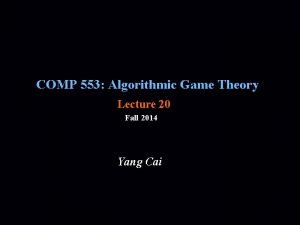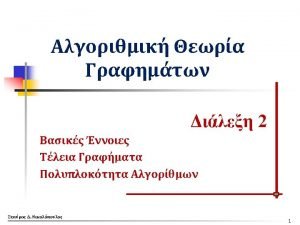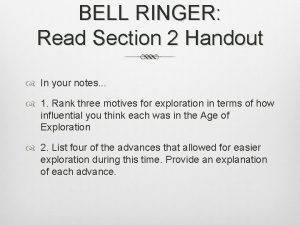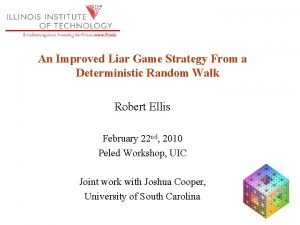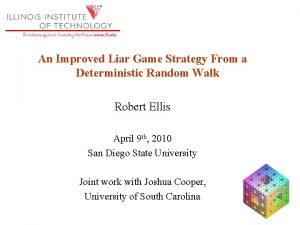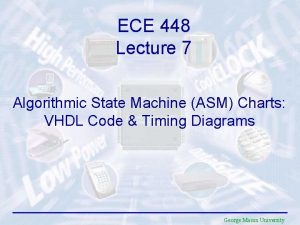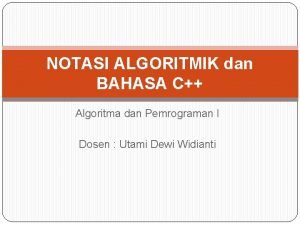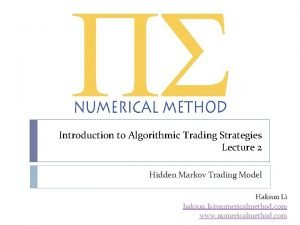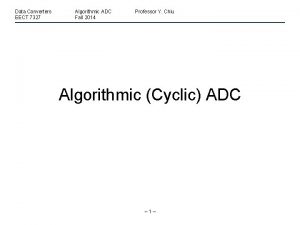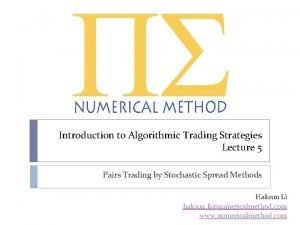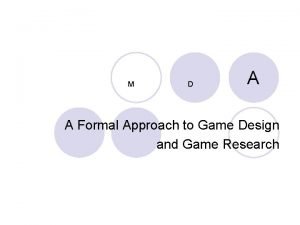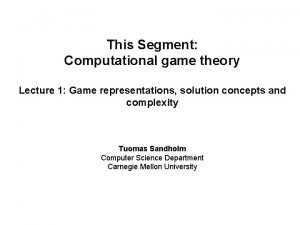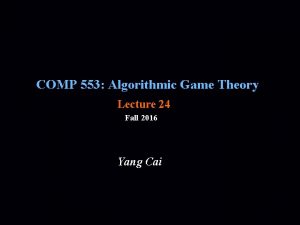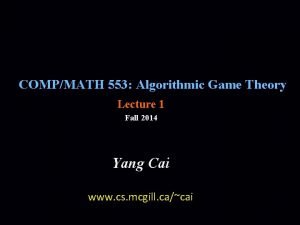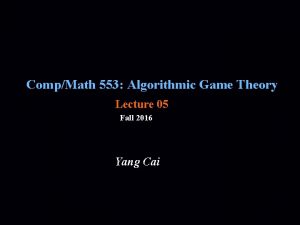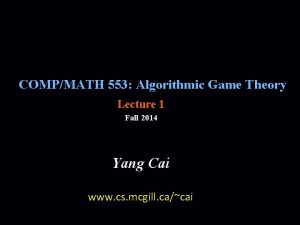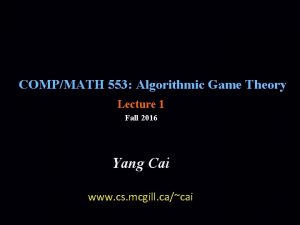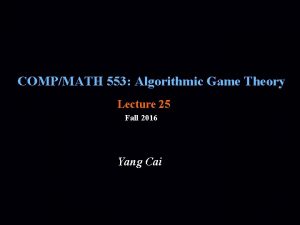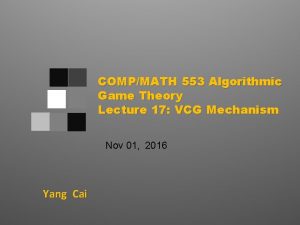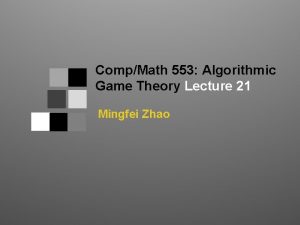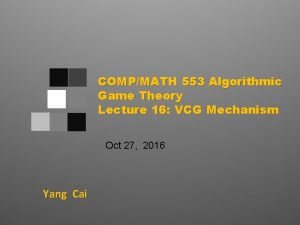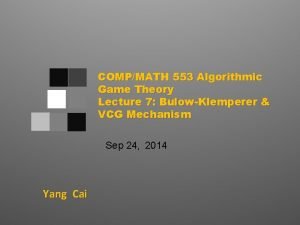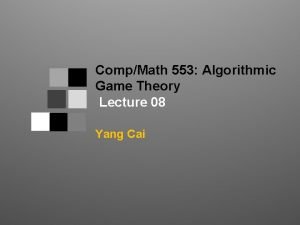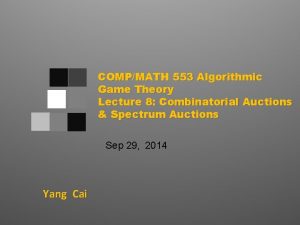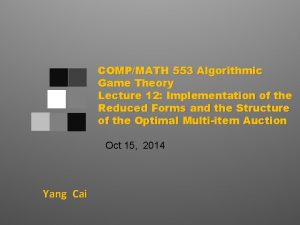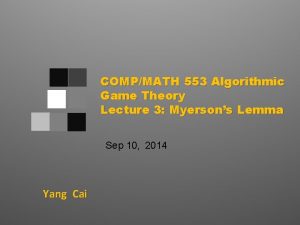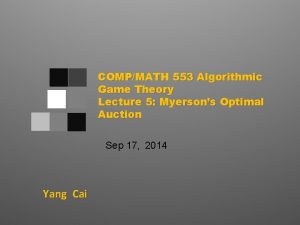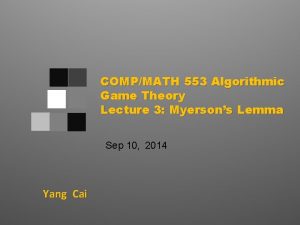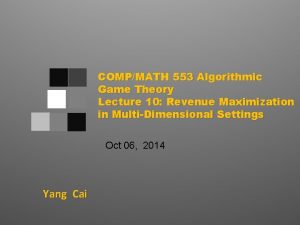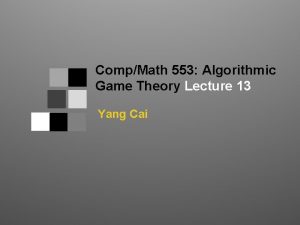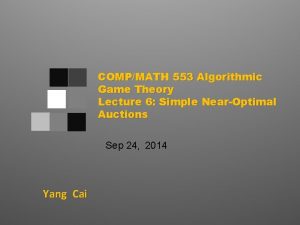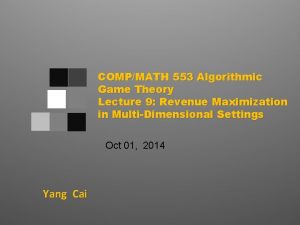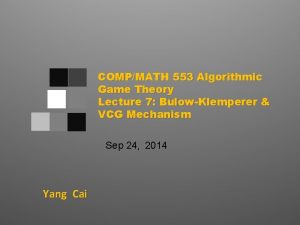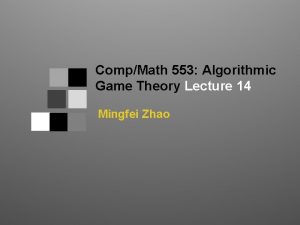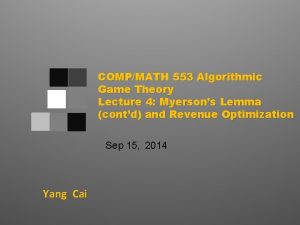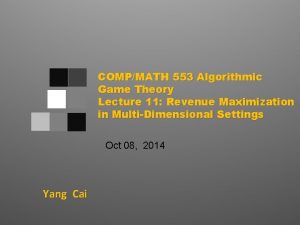COMP 553 Algorithmic Game Theory Lecture 20 Fall
























![2 D-Brouwer on the Square Suppose : [0, 1]2, continuous must be uniformly continuous 2 D-Brouwer on the Square Suppose : [0, 1]2, continuous must be uniformly continuous](https://slidetodoc.com/presentation_image_h/efc8b591b4f786f780569e32ec5d4595/image-25.jpg)
![2 D-Brouwer on the Square Suppose : [0, 1]2, continuous must be uniformly continuous 2 D-Brouwer on the Square Suppose : [0, 1]2, continuous must be uniformly continuous](https://slidetodoc.com/presentation_image_h/efc8b591b4f786f780569e32ec5d4595/image-26.jpg)
![2 D-Brouwer on the Square Suppose : [0, 1]2, continuous must be uniformly continuous 2 D-Brouwer on the Square Suppose : [0, 1]2, continuous must be uniformly continuous](https://slidetodoc.com/presentation_image_h/efc8b591b4f786f780569e32ec5d4595/image-27.jpg)
![2 D-Brouwer on the Square Suppose : [0, 1]2, continuous must be uniformly continuous 2 D-Brouwer on the Square Suppose : [0, 1]2, continuous must be uniformly continuous](https://slidetodoc.com/presentation_image_h/efc8b591b4f786f780569e32ec5d4595/image-28.jpg)
![2 D-Brouwer on the Square Suppose : [0, 1]2, continuous must be uniformly continuous 2 D-Brouwer on the Square Suppose : [0, 1]2, continuous must be uniformly continuous](https://slidetodoc.com/presentation_image_h/efc8b591b4f786f780569e32ec5d4595/image-29.jpg)

![2 D-Brouwer on the Square Suppose : [0, 1]2, continuous must be uniformly continuous 2 D-Brouwer on the Square Suppose : [0, 1]2, continuous must be uniformly continuous](https://slidetodoc.com/presentation_image_h/efc8b591b4f786f780569e32ec5d4595/image-31.jpg)






- Slides: 37

COMP 553: Algorithmic Game Theory Lecture 20 Fall 2014 Yang Cai

In last lecture, we showed Nash’s theorem that a Nash equilibrium exists in every game. In our proof, we used Brouwer’s fixed point theorem as a Blackbox. In today’s lecture, we explain Brouwer’s theorem, and give an illustration of Nash’s proof. We proceed to prove Brouwer’s Theorem using a combinatorial lemma, called Sperner’s Lemma, whose proof we also provide.

Brouwer’ s Fixed Point Theorem

Brouwer’s fixed point theorem Theorem: Let f : D D be a continuous function from a convex and compact subset D of the Euclidean space to itself. Then there exists an x s. t. x = f (x). closed and bounded Below we show a few examples, when D is the 2 -dimensional disk. f D D N. B. All conditions in the statement of theorem are necessary.

Brouwer’s fixed point theorem fixed point

Brouwer’s fixed point theorem fixed point

Brouwer’s fixed point theorem fixed point

Nash’s Proof

Nash’s Function where:

Visualizing Nash’s Construction Kick Dive Left 1 , -1 -1 , 1 Right -1 , 1 1, -1 Right Penalty Shot Game : [0, 1]2, continuous such that fixed points Nash eq.

Visualizing Nash’s Construction Kick Dive Left Right Left 1 , -1 -1 , 1 Right -1 , 1 1, -1 Penalty Shot Game Pr[Right] 0 0 1 Pr[Right] 1

Visualizing Nash’s Construction Kick Dive Left Right Left 1 , -1 -1 , 1 Right -1 , 1 1, -1 Penalty Shot Game Pr[Right] 0 0 1 Pr[Right] 1

Visualizing Nash’s Construction Kick Dive Left Right Left 1 , -1 -1 , 1 Right -1 , 1 1, -1 Penalty Shot Game Pr[Right] 0 0 1 Pr[Right] 1

Visualizing Nash’s Construction ½ Kick Dive Left Right ½ Left 1 , -1 -1 , 1 ½ Right -1 , 1 1, -1 Penalty Shot Game 0 0 Pr[Right] ½ Pr[Right] 1 : [0, 1]2, cont. such that fixed point Nash eq. 1 fixed point

Sperner’s Lemma

Sperner’s Lemma

Sperner’s Lemma no blue no red Lemma: Color the boundary using three colors in a legal way. no yellow

Sperner’s Lemma no yellow no blue no red Lemma: Color the boundary using three colors in a legal way. No matter how the internal nodes are colored, there exists a tri-chromatic triangle. In fact an odd number of those.

Sperner’s Lemma: Color the boundary using three colors in a legal way. No matter how the internal nodes are colored, there exists a tri-chromatic triangle. In fact an odd number of those.

Sperner’s Lemma: Color the boundary using three colors in a legal way. No matter how the internal nodes are colored, there exists a tri-chromatic triangle. In fact an odd number of those.

Proof of Sperner’s Lemma For convenience we introduce an outer boundary, that does not create new trichromatic triangles. Next we define a directed walk starting from the bottom-left triangle. Lemma: Color the boundary using three colors in a legal way. No matter how the internal nodes are colored, there exists a tri-chromatic triangle. In fact an odd number of those.

Proof of Sperner’s Lemma Space of Triangles Transition Rule: ? If red - yellow door cross it with red on your left hand. 2 1 Lemma: Color the boundary using three colors in a legal way. No matter how the internal nodes are colored, there exists a tri-chromatic triangle. In fact an odd number of those.

Proof of Sperner’s Lemma Claim: The walk cannot exit the square, nor can it loop around itself in a rho-shape. Hence, it must stop somewhere inside. This can only happen at tri-chromatic triangle… For convenience we introduce an outer boundary, that does not create new trichromatic triangles. ! Next we define a directed walk starting from the bottom-left triangle. Starting from other triangles we do the same going forward or backward. Lemma: Color the boundary using three colors in a legal way. No matter how the internal nodes are colored, there exists a tri-chromatic triangle. In fact an odd number of those.

Proof of Brouwer’s Fixed Point Theorem We show that Sperner’s Lemma implies Brouwer’s Fixed Point Theorem. We start with the 2 -dimensional Brouwer problem on the square.
![2 DBrouwer on the Square Suppose 0 12 continuous must be uniformly continuous 2 D-Brouwer on the Square Suppose : [0, 1]2, continuous must be uniformly continuous](https://slidetodoc.com/presentation_image_h/efc8b591b4f786f780569e32ec5d4595/image-25.jpg)
2 D-Brouwer on the Square Suppose : [0, 1]2, continuous must be uniformly continuous (by the Heine-Cantor theorem) 1 0 0 1
![2 DBrouwer on the Square Suppose 0 12 continuous must be uniformly continuous 2 D-Brouwer on the Square Suppose : [0, 1]2, continuous must be uniformly continuous](https://slidetodoc.com/presentation_image_h/efc8b591b4f786f780569e32ec5d4595/image-26.jpg)
2 D-Brouwer on the Square Suppose : [0, 1]2, continuous must be uniformly continuous (by the Heine-Cantor theorem) 1 choose some and triangulate so that the diameter of cells is 0 0 1
![2 DBrouwer on the Square Suppose 0 12 continuous must be uniformly continuous 2 D-Brouwer on the Square Suppose : [0, 1]2, continuous must be uniformly continuous](https://slidetodoc.com/presentation_image_h/efc8b591b4f786f780569e32ec5d4595/image-27.jpg)
2 D-Brouwer on the Square Suppose : [0, 1]2, continuous must be uniformly continuous (by the Heine-Cantor theorem) color the nodes of the triangulation according to the direction of 1 choose some and triangulate so that the diameter of cells is 0 0 1
![2 DBrouwer on the Square Suppose 0 12 continuous must be uniformly continuous 2 D-Brouwer on the Square Suppose : [0, 1]2, continuous must be uniformly continuous](https://slidetodoc.com/presentation_image_h/efc8b591b4f786f780569e32ec5d4595/image-28.jpg)
2 D-Brouwer on the Square Suppose : [0, 1]2, continuous must be uniformly continuous (by the Heine-Cantor theorem) color the nodes of the triangulation according to the direction of 1 choose some and triangulate so that the diameter of cells is tie-break at the boundary angles, so that the resulting coloring respects the boundary 0 conditions required by 0 Sperner’s lemma find a trichromatic triangle, guaranteed by Sperner 1
![2 DBrouwer on the Square Suppose 0 12 continuous must be uniformly continuous 2 D-Brouwer on the Square Suppose : [0, 1]2, continuous must be uniformly continuous](https://slidetodoc.com/presentation_image_h/efc8b591b4f786f780569e32ec5d4595/image-29.jpg)
2 D-Brouwer on the Square Suppose : [0, 1]2, continuous must be uniformly continuous (by the Heine-Cantor theorem) 1 Claim: If z. Y is the yellow corner of a trichromatic triangle, then 0 0 1

Proof of Claim: If z. Y is the yellow corner of a trichromatic triangle, then Proof: Let z. Y, z. R , z. B be the yellow/red/blue corners of a trichromatic triangle. By the definition of the coloring, observe that the product of Hence: 1 Similarly, we can show: 0 0 1
![2 DBrouwer on the Square Suppose 0 12 continuous must be uniformly continuous 2 D-Brouwer on the Square Suppose : [0, 1]2, continuous must be uniformly continuous](https://slidetodoc.com/presentation_image_h/efc8b591b4f786f780569e32ec5d4595/image-31.jpg)
2 D-Brouwer on the Square Suppose : [0, 1]2, continuous must be uniformly continuous (by the Heine-Cantor theorem) 1 Claim: If z. Y is the yellow corner of a trichromatic triangle, then Choosing 0 0 1

2 D-Brouwer on the Square Finishing the proof of Brouwer’s Theorem: - pick a sequence of epsilons: - define a sequence of triangulations of diameter: - pick a trichromatic triangle in each triangulation, and call its yellow corner - by compactness, this sequence has a converging subsequence with limit point Claim: Proof: Define the function is continuous and so is But Therefore, . Clearly, is continuous since. It follows from continuity that . Hence, . It follows that .

How hard is computing a Nash Equilibrium?

NASH, BROUWER and SPERNER We informally define three computational problems: • NASH: find a (appx-) Nash equilibrium in a n player game. • BROUWER: find a (appx-) fixed point x for a continuous function f(). • SPERNER: find a trichromatic triangle (panchromatic simplex) given a legal coloring.

Function NP (FNP) A search problem L is defined by a relation RL(x, y) such that RL(x, y)=1 iff y is a solution to x A search problem is called total iff for all x there exists y such that RL(x, y) =1. A search problem L belongs to FNP iff there exists an efficient algorithm AL(x, y) and a polynomial function p. L( ) such that (i) if AL(x, z)=1 RL(x, z)=1 (ii) if y s. t. RL(x, y)=1 z with |z| ≤ p. L(|x|) such that AL(x, z)=1 Clearly, SPERNER FNP.

Reductions between Problems A search problem L FNP, associated with AL(x, y) and p. L , is polynomial-time reducible to another problem L’ FNP, associated with AL’(x, y) and p. L’, iff there exist efficiently computable functions f, g such that (i) x is input to L f(x) is input to L’ (ii) AL’ (f(x), y)=1 AL(x, g(y))=1 RL’ (f(x), y)=0, y RL(x, y)=0, y A search problem L is FNP-complete iff e. g. SAT L FNP L’ is poly-time reducible to L, for all L’ FNP

Our Reductions (intuitively) NASH BROUWER SPERNER FNP both Reductions are polynomial-time Is then SPERNER FNP-complete? - With our current notion of reduction the answer is no, because SPERNER always has a solution, while a SAT instance may not have a solution; - To attempt an answer to this question we need to update our notion of reduction. Suppose we try the following: we require that a solution to SPERNER informs us about whether the SAT instance is satisfiable or not, and provides us with a solution to the SAT instance in the ``yes’’ case; but if such a reduction existed, it could be turned into a non-deterministic algorithm for checking “no” answers to SAT: guess the solution to SPERNER; this will inform you about whether the answer to the SAT instance is “yes” or “no”, leading to … - Another approach would be to turn SPERNER into a non-total problem, e. g. by removing the boundary conditions; this way, SPERNER can be easily shown FNPcomplete, but all the structure of the original problem is lost in the reduction.
 Comp 553
Comp 553 Algorithmic graph theory and perfect graphs
Algorithmic graph theory and perfect graphs Ece 553
Ece 553 ?3305501049 0000 28|.|091 27|.|071 98|.|553 102|.|311 13`
?3305501049 0000 28|.|091 27|.|071 98|.|553 102|.|311 13` Reread the primary source on page 553
Reread the primary source on page 553 01:640:244 lecture notes - lecture 15: plat, idah, farad
01:640:244 lecture notes - lecture 15: plat, idah, farad The pirate game
The pirate game Game lab game theory
Game lab game theory Liar game game theory
Liar game game theory Liar game game theory
Liar game game theory Algorithmic trading singapore
Algorithmic trading singapore Asm chart examples
Asm chart examples Algorithmic thinking gcse
Algorithmic thinking gcse Algorithmic nuggets in content delivery
Algorithmic nuggets in content delivery Algorithmic cost modelling
Algorithmic cost modelling Contoh algoritma bahasa c
Contoh algoritma bahasa c Introduction to algorithmic trading strategies
Introduction to algorithmic trading strategies Introduction to algorithmic trading strategies
Introduction to algorithmic trading strategies Input and output algorithm
Input and output algorithm Low frequency algorithmic trading
Low frequency algorithmic trading Introduction to algorithmic trading strategies
Introduction to algorithmic trading strategies Algorithmic adc
Algorithmic adc Kalman filter trading strategy
Kalman filter trading strategy Correlation rules in data mining
Correlation rules in data mining Algorithmic state machine examples
Algorithmic state machine examples Gdpr algorithmic bias
Gdpr algorithmic bias Game theory and graph theory
Game theory and graph theory Game design lecture
Game design lecture Natural language processing nlp - theory lecture
Natural language processing nlp - theory lecture Decision theory lecture notes
Decision theory lecture notes Sargur srihari
Sargur srihari Natural language processing nlp - theory lecture
Natural language processing nlp - theory lecture The farming game board game
The farming game board game A formal approach to game design and game research
A formal approach to game design and game research Zero sum game
Zero sum game Jeopardy game maker
Jeopardy game maker Information sets in game theory
Information sets in game theory Game theory in strategic management
Game theory in strategic management
